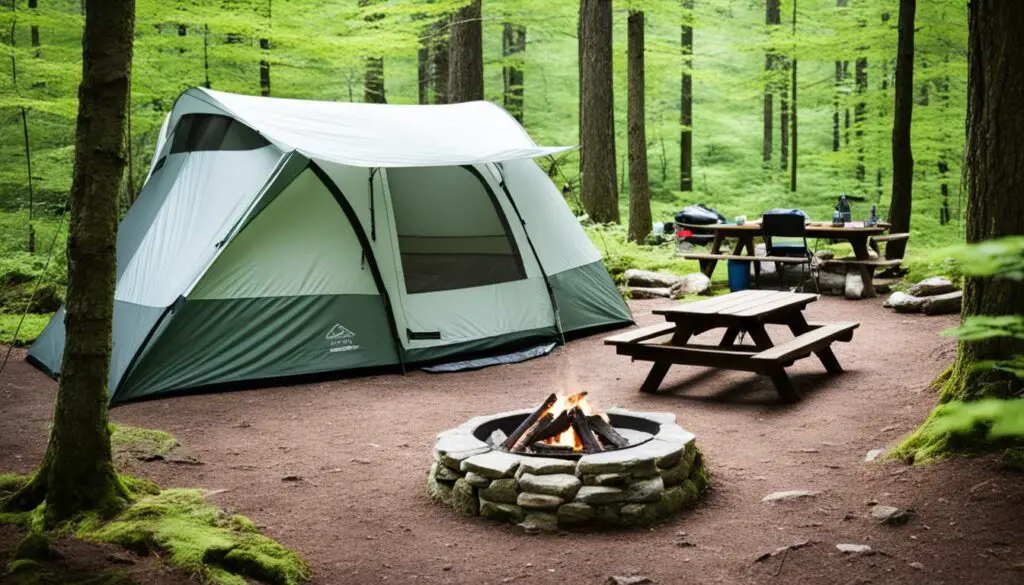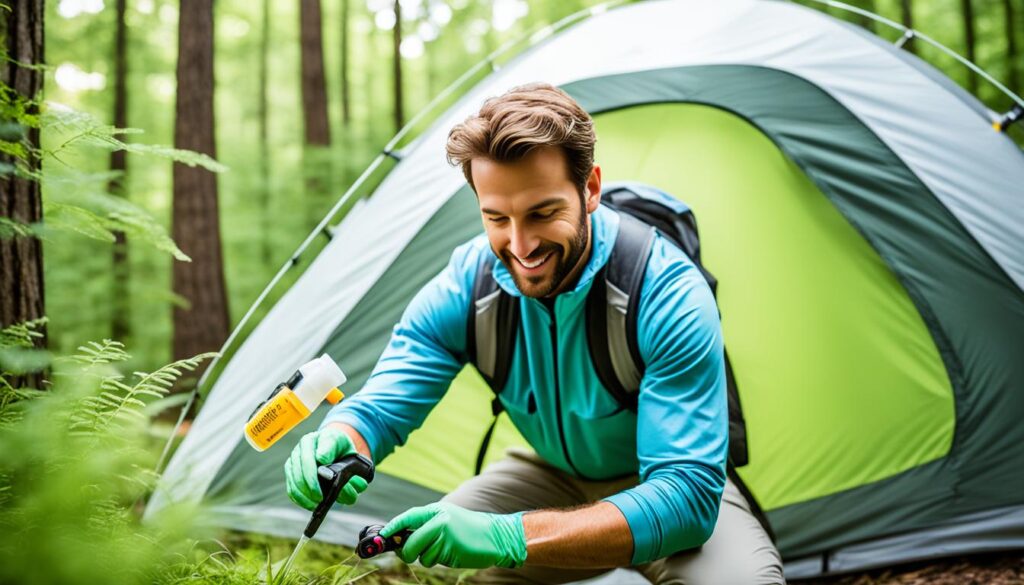Prevent Ticks Camping
As an avid camper, I love getting into nature. But the outside world has some risks too, like ticks. Ticks are small bugs that can carry serious diseases like Lyme disease. I’m here to help you learn how to prevent ticks while camping. This will make sure your nature trips are safe and fun.
Ticks can be very dangerous, so it’s key to protect yourself and those you love. I’ll teach you about the types of ticks and the diseases they can spread. You’ll know how to stay safe by picking the right clothes and maintaining your campsite. With these tips, you can camp without worrying about ticks.
Understanding Ticks and the Risks
To keep ticks away while camping, knowing the types and how they act is key. In the United States, you mainly find the deer tick, lone star tick, and American dog tick. They live in many places, like forests, grasslands, and yards.
Types of Ticks and Their Behavior
Deer ticks, or blacklegged ticks, cause Lyme disease and live in the northeast and upper Midwest. Lone star ticks, with a white spot, are in the south. They can give you ehrlichiosis. The American dog tick causes Rocky Mountain spotted fever and is found across the country.
Their four-stage life cycle includes egg, larva, nymph, and adult. They need blood meals from hosts, like animals and people, at every stage. So, they are always a risk when you’re out camping.
Diseases Transmitted by Ticks
- Lyme disease is known for fever, headaches, and a bullseye rash.
- Rocky Mountain spotted fever can be very serious, Zaidi says, causing a high fever and organ damage.
- Ehrlichiosis has flu-like symptoms and can lead to dangerous issues.
It’s vital to know about these diseases and how they show up. Early treatment is very important if you think you’ve been bitten.
| Tick Species | Habitat | Diseases Transmitted |
|---|---|---|
| Deer Tick | Northeastern and upper Midwestern regions | Lyme disease |
| Lone Star Tick | Southeastern and south-central states | Ehrlichiosis |
| American Dog Tick | Eastern, central, and western regions | Rocky Mountain spotted fever |
Prevent Ticks Camping: Essential Precautions
Camping is exciting, but it has tick risks. So, it is important to be safe. Prepare well before and during your trip to avoid ticks and diseases they carry.
Pre-Trip Planning
Start by planning. Look up the tick situation where you’ll camp. Then, you can pack and get ready the right way. Know about tick illnesses to watch out for their signs.
Tick-Proof Camping Gear
Choose the right clothes and gear to fight ticks. Wear light colors and tight-weave fabrics. Use insect repellent on your stuff. It should have permethrin to keep ticks off. Wear long clothes to cover your skin.
Tick-Deterring Tactics
At your campsite, do things to avoid ticks. Check yourself and your clothes often. Look closely at places like your head, armpits, and groin. If you find ticks, remove them right away with tweezers.
Keep your camping area clean. Pick a spot without high grass. This avoids places where ticks like to hide.
These steps will help you lower the chance of getting ticks. They make outdoor camping safer and more enjoyable, with fewer worries about ticks.
Proper Clothing and Gear for Tick Prevention
Picking the right clothes and gear is key to avoid ticks outdoors. Choose items that keep ticks away. Use insect spray right to lower your risk of tick diseases.
Choosing the Right Fabrics and Colors
Choose light, long-sleeved tops and pants made of thick material. Clothes with permethrin scare off ticks. It’s good to pick clothes in light colors, too. Ticks don’t like them and won’t stick around.
Applying Insect Repellents Effectively
Using insect repellents the right way is also important. Pick DEET products or ones with lemon eucalyptus oil. Make sure to put repellent on all bare skin. Remember to put more on when needed.
| Fabric Type | Effectiveness Against Ticks |
|---|---|
| Tightly-woven, lightweight fabrics | High |
| Permethrin-treated gear | Extremely high |
| Loose, breathable fabrics | Low |
By wearing the right clothes and using repellent well, you can stay safe from ticks and their illnesses. Have fun camping without worries.
Campsite Selection and Maintenance
Picking the right spot and keeping it clean are key to avoid ticks while camping. Choose an area without ticks and stay on top of keeping it that way. This will make sure you don’t run into these tiny travelers.
Identifying Tick-Prone Areas
To avoid ticks, choose a spot they don’t like. They prefer tall grass, dense plants, and trees. Make sure your campsite location is away from these places where ticks love to hang out.
Look for sunny spots without a lot of plants close to your tent. Stay away from the edges of forests and long grass. This helps keep ticks at bay, making your tick-free camping dreams come true.
Campsite Cleaning and Maintenance
Keeping your campsite tidy is important to ward off ticks. Sweep away leaves and branches. Check for ticks often to keep your site safe.
If you can, set up on hard ground like concrete or gravel. This makes it harder for ticks to be around, keeping you safer during your trip.
| Campsite Feature | Tick Habitat Preference | Recommended for Tick-Free Camping |
|---|---|---|
| Grass and vegetation | High | Avoid |
| Wooded areas | High | Avoid |
| Open, sunny areas | Low | Preferred |
| Hard, dry surfaces | Low | Preferred |
Pick your campsite location wisely and keep it neat to avoid ticks. This helps you relax and enjoy being outdoors without worry.

Conclusion
As we end our chat, I want to stress how important it is to keep ticks away when you camp. By using the tips in this piece, camping will be much safer. You can lower the chance of getting sick from ticks. Steps like picking the right clothes, using good bug sprays, checking your camp spot, and staying tidy are key. They all help in keeping you, your friends, and family safe.
It’s key to wear light, long clothes and keep them tucked in. Also, always use bug sprays that are okayed by the EPA. Check for ticks often, on yourself and your pets. Make sure your camp area is clear of tick signs. This way, you can love being outside without worry about tick diseases.
Remember, being safe while you’re outside is top priority. These tips are great for avoiding ticks and enjoying nature. Hold onto the calm and beauty the outdoors brings. Stay happy knowing you’ve shielded your loved ones and yourself from tick threats.
FAQ
What are the most common types of ticks and their preferred habitats?
The common tick species found in camping areas are the blacklegged tick, the American dog tick, and the lone star tick. They like wooded and grassy places. They easily attach to people and animals passing by.
What diseases can ticks transmit, and what are the symptoms?
Ticks can carry diseases like Lyme disease and Rocky Mountain spotted fever. They also spread ehrlichiosis. Symptoms might be fever, headache, and fatigue. When you get Lyme disease, you might see a bullseye rash.
How can I choose the right clothing and gear to prevent tick bites?
For tick prevention, wear light, long-sleeved shirts, long pants, and closed shoes. Put your pants in your socks to make a barrier. You can also use insect repellents with DEET or wear clothes treated with permethrin.
How should I inspect for and remove ticks after being outdoors?
After being in tick areas, check your body for ticks. Look well in hard-to-see places like your scalp. If you find a tick, use tweezers to pull it out gently. Pull straight out. Don’t twist or crush it.
What steps can I take to maintain a tick-free campsite?
To keep a campsite tick-free, camp away from tall grass and woods. Clear the area of leaves and tall plants. Also, keep your camp clean and food stored in sealed containers. This keeps rodents away, which might carry ticks.
How can I effectively use insect repellents to prevent tick bites?
When using repellents, put them on your skin and clothes. Follow the label instructions. Reapply if needed, like after sweating. Don’t spray your face. Put the repellent on your hands and then rub it on your face.
